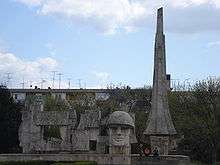Battle of Carei
The Battle of Carei was the last stage of liberation of Romania's current territory during World War II,[1] and occurred in the wider context of the Battle of Debrecen. On October 25, 1944, the cities of Carei and Satu Mare were freed from Hungarian and German control, and the 1940 Second Vienna Award was de facto abrogated. By a decree from 1959, this day was established as the Romanian Armed Forces Day.[1][2]

The Battle
The offensive to retake the remaining corner of Northern Transylvania started on October 9, 1944, and was carried out by the Fourth Army, under the command of General Gheorghe Avramescu.[1] On the evening of October 24, the 6th Army Corps attacked in the direction of Carei with a force comprising 4 divisions, while the 2nd Infantry Division of 2nd Army Corps attacked in the direction of Satu Mare, in a pincer movement. By nightfall, the soldiers of the 9th Infantry Division entered Carei, where they engaged in street fighting; by the next morning, the Romanian Army was in control of the city.[3] Units of the Romanian Gendarmerie participated in the fight, hoisting at the end the national flag on the obelisk in the centre of Carei.[4]
Commemoration
The Romanian Armed Forces Day, which commemorates the Battle of Carei, was established by Decree nr. 381 of 1 October 1959, only after the end of the Soviet occupation of Romania in August 1958, and the process of de-Stalinization started by Gheorghe Gheorghiu-Dej earlier in 1959.[1]
In memory of this battle, the "Monument of the Romanian Soldier" was erected in the center of Carei. Inaugurated in 1964, the monumental complex is the work of the sculptor Gheza Vida and the architect Anton Dâmboianu. Made of white stone, the monument is 18 m wide, 5 m deep, and 12 m high; it bears the inscription, "Glory to the soldiers of the Romanian Army, fallen in the struggles for the liberation of the homeland."[5]
See also
References
- Curtifan, Tudor (25 October 2019). "Ziua Armatei – Bătălia de la Carei – Ultima palmă de pământ românesc eliberată în Ardeal". defenseromania.ro (in Romanian). Retrieved 17 August 2020.
- "Travels through the border from Szabolcs to Carei" (PDF). County Museum Satu Mare. 2011. Retrieved 16 August 2020.
- "Despre această zi puțini vorbesc. Pe 25 octombrie 1944 armata română elibera ultimul colț de pământ românesc în Bătălia de la Carei!". authenticmagazin.com (in Romanian). Retrieved 16 August 2020.
- Lică, Sorin (30 March 2018). "Romanian Gendarmerie – An Important Factor During the Two World Wars (Jandarmeria Română – Un Factor Important În Cele Două Războaie Mondiale)". SSRN 3163437. Cite journal requires
|journal=(help) - "Liberation Memorial Carei – Carei – TracesOfWar.com". www.tracesofwar.com.